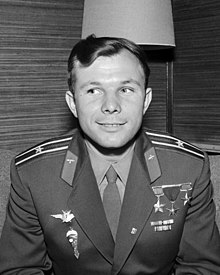
Back Sowjet-ruimteprogram Afrikaans برنامج الفضاء السوفيتي Arabic Programa espacial de la Xunión Soviética AST Sovet kosmik proqramı Azerbaijani Космонавтика в СССР Bulgarian সোভিয়েত ইউনিয়নের মহাকাশ কর্মসূচি Bengali/Bangla Programa espacial soviètic Catalan بەرنامەی بۆشاییی سۆڤیەت CKB Sovětský kosmický program Czech Sowjetische Raumfahrt German
A request that this article title be changed to Space program of the Soviet Union is under discussion. Please do not move this article until the discussion is closed. |
| Космическая программа СССР Kosmicheskaya programma SSSR | |
Launch of the first successful artificial satellite, Sputnik-1, from R-7 platform in 1957. | |
| Formed | 1955–1991 |
|---|---|
| Dissolved | November 14, 1991[1][2] |
| Manager |
|
| Key people | Design Bureaus |
| Primary spaceport | Cosmodrome Baikonur, Plesetsk |
| First flight | Sputnik 1 (October 4, 1957) |
| First crewed flight | Vostok 1 (April 12, 1961) |
| Last crewed flight | Soyuz TM-13 (October 2, 1991) |
| Successes | See accomplishments |
| Failures | See failures below |
| Partial failures | See partial or cancelled projects Soviet lunar program |
| Part of a series of articles on the |
| Soviet space program |
|---|

The Soviet space program[3] (Russian: Космическая программа СССР, romanized: Kosmicheskaya programma SSSR) was the state space program of the Union of Soviet Socialist Republics (USSR), active from 1955 until the dissolution of the Soviet Union in 1991.[4][5][6] Contrary to its American, European, and Chinese competitors, which had their programs run under single coordinating agencies, the Soviet space program was divided between several internally competing design bureaus led by Korolev, Kerimov, Keldysh, Yangel, Glushko, Chelomey, Makeyev, Chertok and Reshetnev.[7] Several of these bureaus were subordinated to the Ministry of General Machine-Building. The Soviet space program served as an important marker of claims by the Soviet Union to its superpower status.[8]: 1
Soviet investigations into rocketry began with the formation of the Gas Dynamics Laboratory in 1921, and these endeavors expanded during the 1930s and 1940s.[9][10] In the years following World War II, both the Soviet and United States space programs utilised German technology in their early efforts at space programs. In the 1950s, the Soviet program was formalized under the management of Sergei Korolev, who led the program based on unique concepts derived from Konstantin Tsiolkovsky, sometimes known as the father of theoretical astronautics.[11]
Competing in the Space Race with the United States and later with the European Union and with China, the Soviet space program was notable in setting many records in space exploration, including the first intercontinental missile (R-7 Semyorka) that launched the first satellite (Sputnik 1) and sent the first animal (Laika) into Earth orbit in 1957, and placed the first human in space in 1961, Yuri Gagarin. In addition, the Soviet program also saw the first woman in space, Valentina Tereshkova, in 1963 and the first spacewalk in 1965. Other milestones included computerized robotic missions exploring the Moon starting in 1959: being the first to reach the surface of the Moon, recording the first image of the far side of the Moon, and achieving the first soft landing on the Moon. The Soviet program also achieved the first space rover deployment with the Lunokhod programme in 1966, and sent the first robotic probe that automatically extracted a sample of lunar soil and brought it to Earth in 1970, Luna 16.[12][13] The Soviet program was also responsible for leading the first interplanetary probes to Venus and Mars and made successful soft landings on these planets in the 1960s and 1970s.[14] It put the first space station, Salyut 1, into low Earth orbit in 1971, and the first modular space station, Mir, in 1986.[15] Its Interkosmos program was also notable for sending the first citizen of a country other than the United States or Soviet Union into space.[16][17]
- ^ "Ministry of General Machine-building of USSR (MOM)". Archived from the original on October 2, 2023. Retrieved May 31, 2024.
- ^ Полвека без Королёва, zavtra.ru. Archived 28 June 2016 at the Wayback Machine.
- ^ Reichl, Eugen (2019). The Soviet Space Program: The Lunar Mission Years: 1959–1976. Atglen, PA: Schiffer Publishing, Limited. p. 160. ISBN 978-0-7643-5675-9. Retrieved May 22, 2022.
- ^ "Space Race Timeline".
- ^ "2 апреля 1955 года «Об образовании общесоюзного Министерства общего машиностроения СССР»". Archived from the original on June 10, 2016. Retrieved May 3, 2016.
- ^ Вертикальная структура: как реорганизуется космическая отрасль России, АиФ. Archived 30 May 2016 at the Wayback Machine.
- ^ "Postal Stationery Russia Airmail Envelope with Depiction of the Earth Being Orbited and Four Gold Stars". groundzerobooksltd.com. Retrieved August 18, 2021.
- ^ Andrews, James T.; Siddiqi, Asif A. (2011). Into the Cosmos: Space Exploration and Soviet Culture. University of Pittsburgh Press. ISBN 978-0-8229-7746-9. Retrieved January 19, 2016.
- ^ Chertok 2005, pp. 9–10, 164–165 Vol 1.
- ^ Siddiqi 2000, pp. 6–14.
- ^ "Home | AIAA". Archived from the original on January 4, 2012.
- ^ "Famous firsts in space". cnn.com. Cable News Network. April 9, 2021. Retrieved May 13, 2022.
- ^ Article title
- ^ "Behind the Iron Curtain: The Soviet Venera program". August 26, 2020.
- ^ Brian Dunbar (April 19, 2021). "50 Years Ago: Launch of Salyut, the World's First Space Station". NASA.gov. National Aeronautics and Space Administration. Archived from the original on March 31, 2022. Retrieved May 13, 2022.
- ^ Sheehan, Michael (2007). The international politics of space. London: Routledge. pp. 59–61. ISBN 978-0-415-39917-3.
- ^ Burgess, Colin; Hall, Rex (2008). The first Soviet cosmonaut team: their lives, legacy, and historical impact. Berlin: Springer. p. 331. ISBN 978-0-387-84823-5.
© MMXXIII Rich X Search. We shall prevail. All rights reserved. Rich X Search